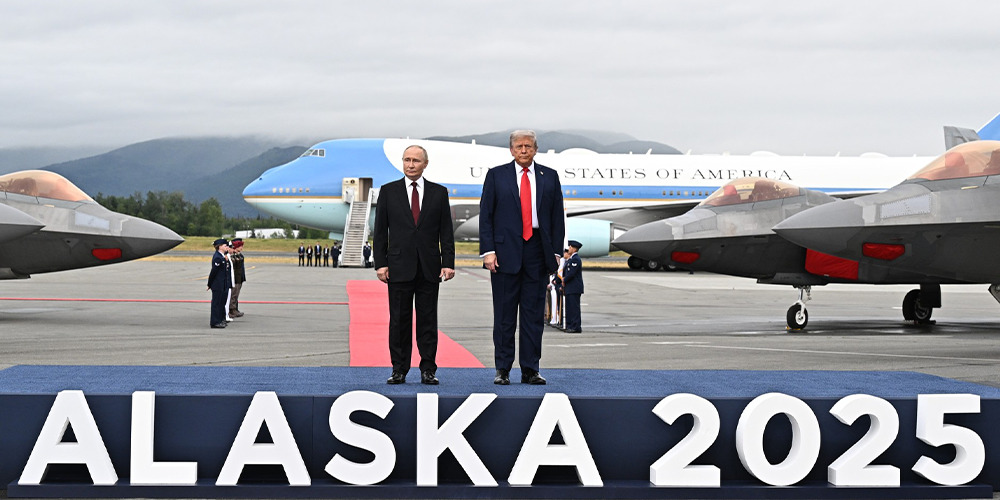The spectacle of European leaders chaperoning Volodymyr Zelenskyy, the Ukrainian president, to the White House shows how, in post-post cold war Europe, the US and Russia are in charge – and Europe is in the back seat.
In 1990, Germany regained full sovereignty, the Soviet Union was in terminal decline and Europe seemed to be driving the action. International diplomacy for deciding the future of Germany was enacted through the framework of the ‘2+4’ negotiations. The ‘two’ represented soon-to-reunify East and West Germany, striking a deal with the four victor powers of the second world war, the US, Soviet Union, Britain and France.
Thirty-five years later, the forum for settling the future of Ukraine seems to be ‘2+8’. This time, the ‘two’ excludes the country whose future is being debated; instead, it represents the US and Russia.
This is not just a sign of abiding, though unpredictable, American global leadership. It is also a considerable – and chilling – diplomatic victory for Vladimir Putin, presiding over a country whose economy is increasingly on the ropes and comprises only 2% of global gross domestic product.
On 18 August Zelenskyy meets President Donald Trump for the next stage in drawn-out efforts to reach a peace settlement between Russia and Ukraine. Putin is not at the table. For the time being, he needs no further credential-burnishing summitry following his red-carpet welcome from Trump at their Alaska encounter on 15 August.
The meeting was a disaster for the US president. Putin recorded a remarkable win by making negligible concessions in exchange for effectively ending Russia’s international diplomatic isolation that had been in place since the full-scale invasion of Ukraine in February 2022.
Accompanying Zelenskyy in Washington are the leaders of Germany, France, Britain, Italy and Finland as well as Ursula von der Leyen, president of the European Commission, and Mark Rutte, Nato secretary general.
Mass arrivals in Washington underline European weakness
The mass arrivals in Washington underline European weakness, not strength. Friedrich Merz, Emmanuel Macron, Keir Starmer, Giorgia Meloni, Alexander Stubb and the others are fulfilling a mix of roles: as strategic counsellors, travelling psychologists and political bodyguards. They fear that, left by himself, Zelensky might fall victim to another version of the psychological steamrollering from which he suffered in his notorious White House visit in February.
But the European prime ministers and presidents are also making the journey for reasons of self-protection. The security of the whole of Europe is at stake. Not only do the leaders have little confidence that the US president will stand up for Europe’s interests; they are actively worried that Trump might sell them out too.
The 1990 diplomatic struggle was over the future of Germany and whether, once unified, it would remain entirely within Nato – a move to which Soviet leader Mikhail Gorbachev (with significant caveats) eventually acquiesced. One of the conditions was the assurance (given verbally on several occasions but never formalised) that Nato would not expand further eastwards beyond East Germany.
In the new constellation in 2025, the battle is over the future of Ukraine. Independent since 1991, the state is fighting for existence in a murderous conflict unleashed by a heavyweight neighbour with which it is indelibly linked by deep strands of history and culture.
Ukraine’s wish to join Nato unlikely to be requited
Among the many inflammatory issues behind the Russian attack is Putin’s desire to quell pluralism and democracy to Russia’s immediate west. But the factors also include Russian hostility to Ukraine’s wish to join Nato – a desire that now seems highly unlikely to be requited.
In 1990, Germany and Europe had a top seat at the table. President George H. W Bush and his negotiating team under James Baker, secretary of state, were hugely influential. The most consequential personal relationship was between West German Chancellor Helmut Kohl and Gorbachev. At crucial moments Bush and Baker were able to let Kohl and his adviser Horst Teltschik make the running – with the basic script set in Washington as the US gained full benefits from cold war victory over the Soviet Union.
This time round, Washington is again in the ascendancy – but paired with Moscow, not Europe. Trump has allowed Russia to come back in from the cold.
The seminal moment in the thaw between the US and the Soviet Union three and a half decades ago was the fall of the Berlin wall in November 1989, followed, more quickly than nearly anyone thought possible, by the unification of Germany and then the break-up of the Soviet Union.
Putin has famously referred to the end-1991 Soviet collapse as the greatest geopolitical catastrophe of the 20th century. Russia’s aspirations to roll back history were symbolised by Sergei Lavrov, foreign minister, turning up in Alaska on 15 August sporting a sweatshirt bearing the initials CCCP (USSR) – as though the Soviet Union had never gone away.
That message has not been lost on the rest of Europe. Unfortunately, in the continent’s present phase of weakness, the main answer to Russia’s great-power pretensions will come not from Berlin, Paris, London or Brussels but from Washington.
Furthermore, it will come from an administration the Europeans do not trust. And no one (including probably Trump himself) can be sure what that answer will be.
David Marsh is Chairman and Mark Sobel is US Chair of OMFIF.
David’s new book, Can Europe Survive? The Story of a Continent in a Fractured World, is launching on 30 September.
Interested in this topic? Subscribe to OMFIF’s newsletter for more.

